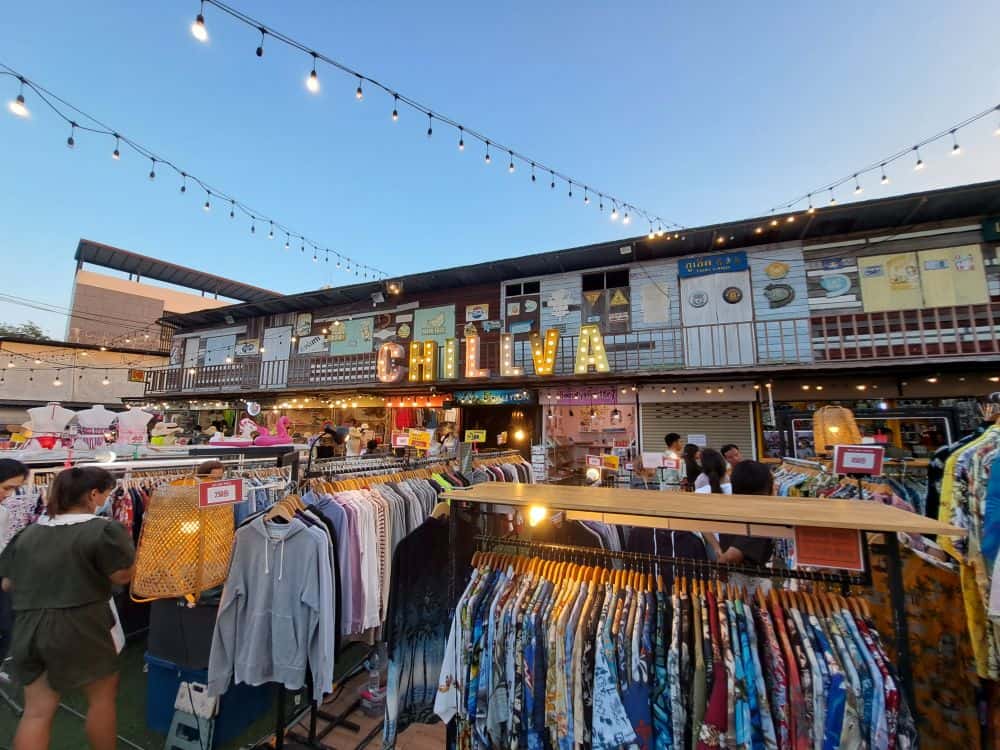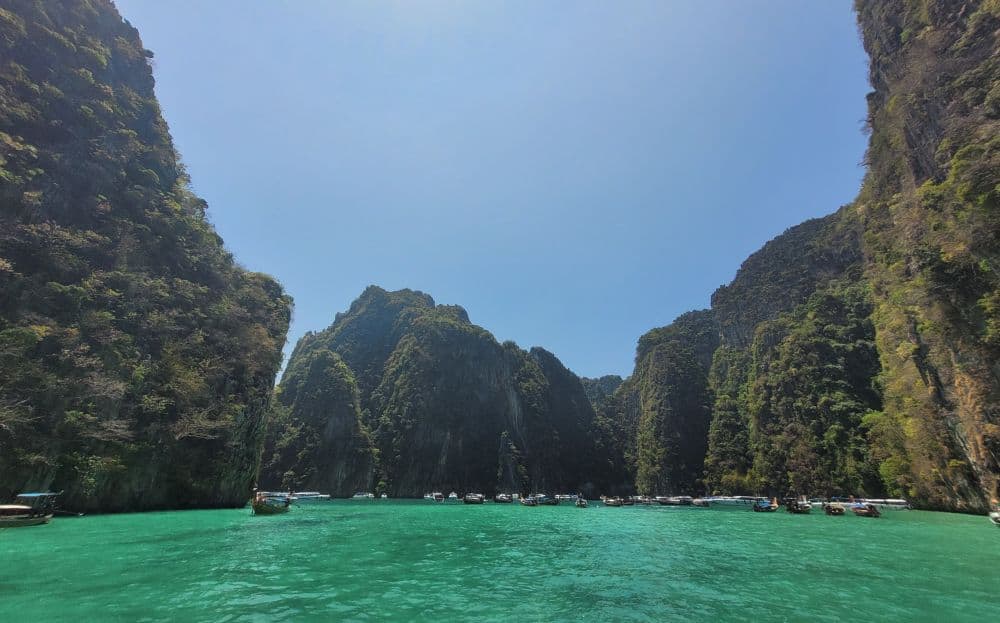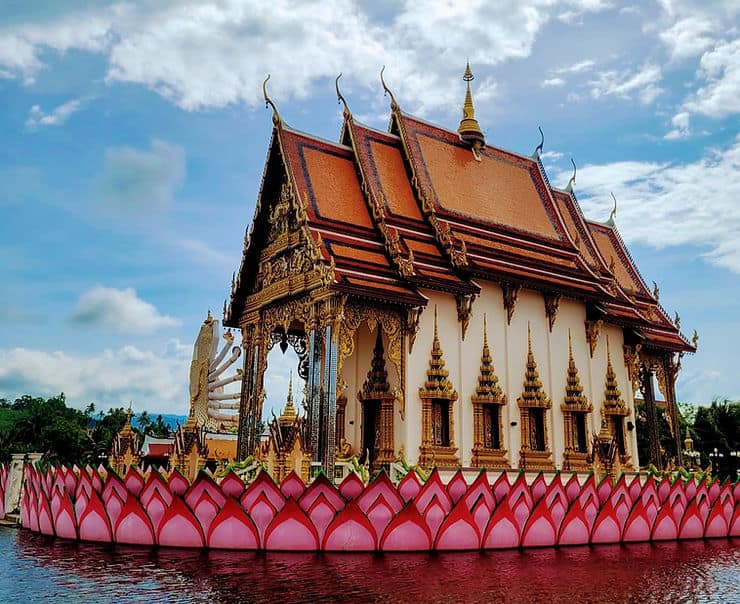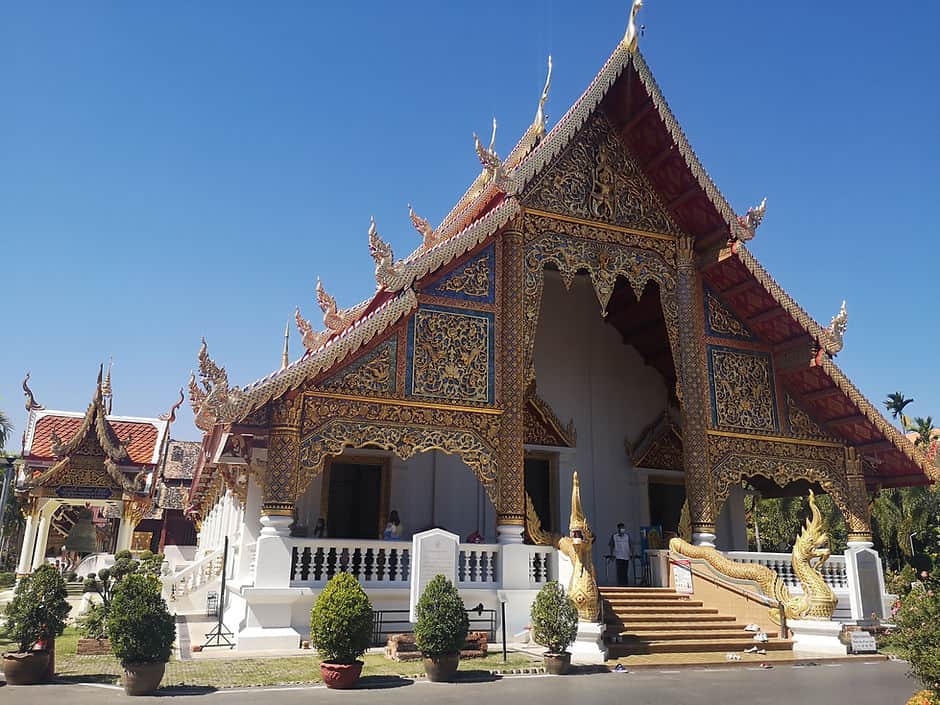
This post may contain affiliate links. I will receive a small commission if you use these links.
Chiang Mai is a beautiful city in Northern Thailand. It has become a popular place for backpackers, tourists and expats alike, and after spending a week here, it’s not hard to see why!
In contrast to the south of Thailand and the laid-back vibe that comes with soft, sandy beaches and island life, Chiang Mai is a busy city, vibrant and diverse. Think western cafes mixed with local Thai markets. Massage salons and spas, shops, restaurants and an abundance of beautiful temples. And that’s just in the city centre. Venture further outside of Chiang Mai and you’ll find plenty of nature to explore in the beautiful mountains that Northern Thailand is known for.
Also read: 50 essential travel tips for visiting Southeast Asia for the first time
Table of Contents
7 day Chiang Mai itinerary: Best things to see and do
Chiang Mai is one of the best places to visit when travelling in Thailand. This beautiful northern city has so much to offer. Here’s a detailed 7 day itinerary for the best things to see and do in Chiang Mai in one week.
Day 1: Wander around Chiang Mai’s old city
Start your visit to Chiang Mai by spending your first day getting to know the old city. Before you set off sightseeing, stop by the Crusty Loaf Bakery for breakfast. As well as fresh bakery items, you can also enjoy eggs, sandwiches or a Full English or American breakfast.
After a hearty breakfast, you’re ready to explore! Most of the temples and tourist sites in Chiang Mai are located in the old city. The area is surrounded by ancient brick walls and a moat. There are four main gates to enter the old city, located along each side of the old city walls. The most impressive city gate is the Tha Phae Gate at the east entrance. The area in front of this ancient gate is often used for many events and markets.
Along the south city wall, near the Pratu gate is the Chiang Mai gate market. Here you’ll find local street food and fresh fruit and vegetables. Further along the south wall, in the southwest corner, is the Nong Buak Haad Park. It’s a lovely green park with a pond and children’s playground. There’s also a walking track around the park which is used for a Park run every Saturday morning. This is a perfect place to have a rest under the shade of the trees.
Inside the city walls you will find an abundance of beautiful temples as well as plenty of shops, markets and cafes. The Fern Forest cafe in the north of the old city is a beautiful cafe with delicious fresh food and tempting cakes for an afternoon treat!
In the centre of the old city is the Three Kings Monument – a large sculpture of Chiang Mai’s founding fathers; Kings Mengrai, Ramkamhaeng and Ngam Muang.
Chiang Mai Night market
In the evening, there are several night markets to explore around Chiang Mai, but the best and most well known market is the Chiang Mai Sunday night market. Every Sunday at 6pm, several of the streets in the centre of Chiang Mai’s old city are closed to traffic and are taken over by market stalls. You can find everything here! There’s live music, street food stalls, arts, craft, jewellery and clothes. It is also a great place to treat yourself to a foot massage after all that walking! Without a doubt, experiencing the Sunday night market is the best thing to do in Chiang Mai and one for your Thailand bucket list.
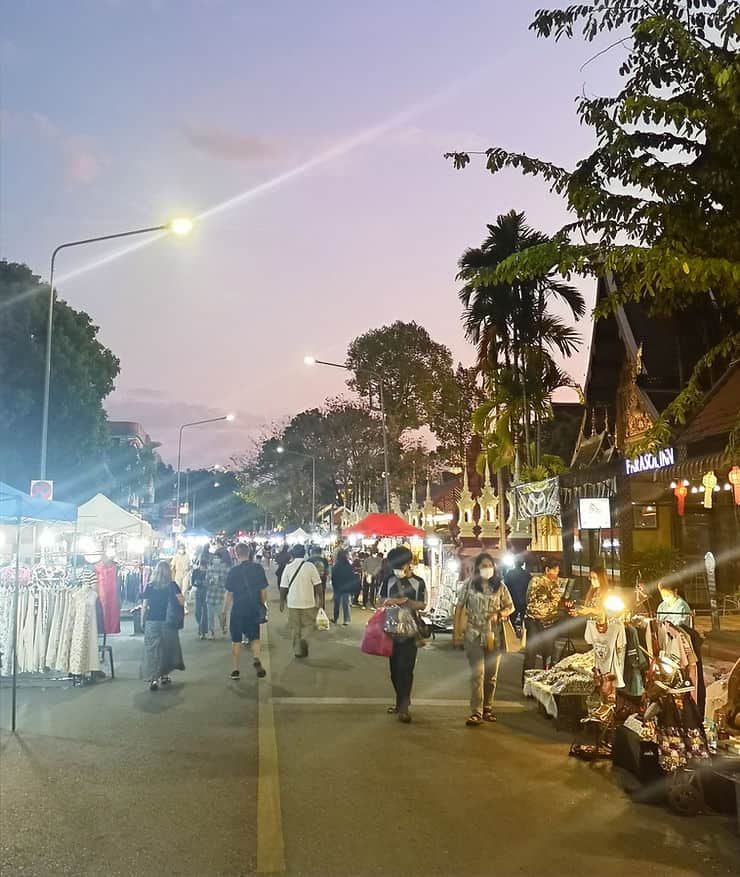
Day 2: Take a day trip to Doi Inthanon National Park
Doi Inthanon is Thailand’s highest peak. Located in the Doi Inthanon National Park, 80km south of the city, it’s a great day trip from Chiang Mai.
You can either hire a car and drive there yourself, or book onto a day tour. Most of the day tours will include stops at a local market, a waterfall, the Twin Pagoda’s. The day tours also include a short nature hike and a visit to the local Karon tribe. If you want to do more hiking, then I would recommend hiring your own car and doing it at your own pace, or booking onto a multi day tour which is specifically for trekking.
Doi Inthanon summit
The actual summit of Doi Inthanon does not have the views you might expect and the highest point of the mountain is actually surrounded by trees. Next to the summit is the Ang Ka Luang Nature Trail. It’s a short, pretty trail on a wooden boardwalk through a lush green forest.
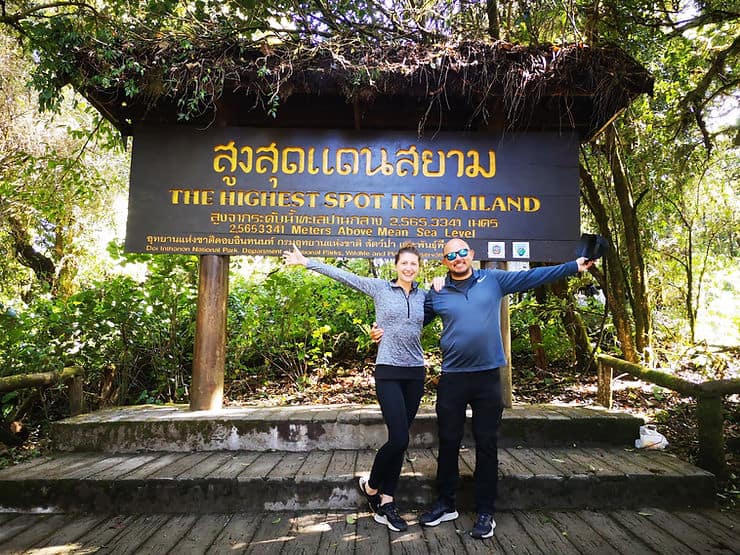
Nature trails at Doi Inthanon National park
One of the best things to do in the Doi Inthanon national park is to walk the short Kew Mae Pan Nature Trail. This circular trail is great because it’s just under 3km and suitable for beginners. It also has some of the best views in the national park! From the Kew Mae Pan viewpoint and along the ridge line you will get stunning panoramic views of the national park, with its deep valleys and mountain ranges. You will also be able to see the giant Twin Pagodas from this trail. Note that this trail is closed during the rainy season June – October.
The Twin Pagodas
After your walk, stop at the Twin Pagodas for a closer look. The pagodas were built to honour the 60th birthdays of the previous (and late) King and Queen of Thailand. Standing on the terraces of the Pagodas, you will have beautiful views across the national park.
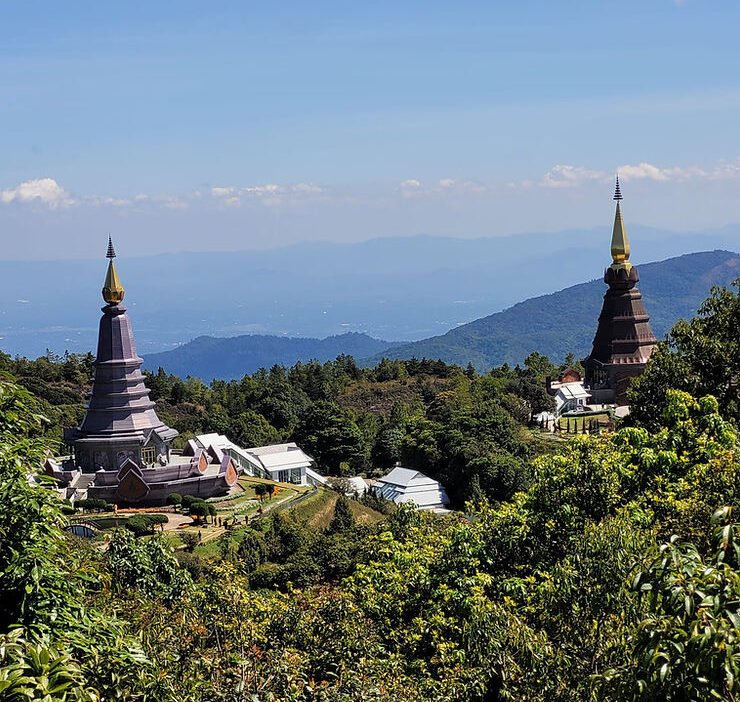
Waterfalls at Doi Inthanon
Another must-see sight within the Doi Inthanon national park is the Wachirathan Waterfall. This impressive waterfall is just a few steps from the car park and although swimming is not permitted in this waterfall, the spray should cool you off! There’s also a couple of restaurants here if you need to recharge! Other great waterfalls to see within the national park are the Mae Klang Waterfall and Mae Pan waterfall. There’s a short hike to each of these, but it is worth it if you have time.
If you have more time to spend in Chiang Mai and want to explore the National Park further, why not stay overnight and explore everything this beautiful place has to offer.
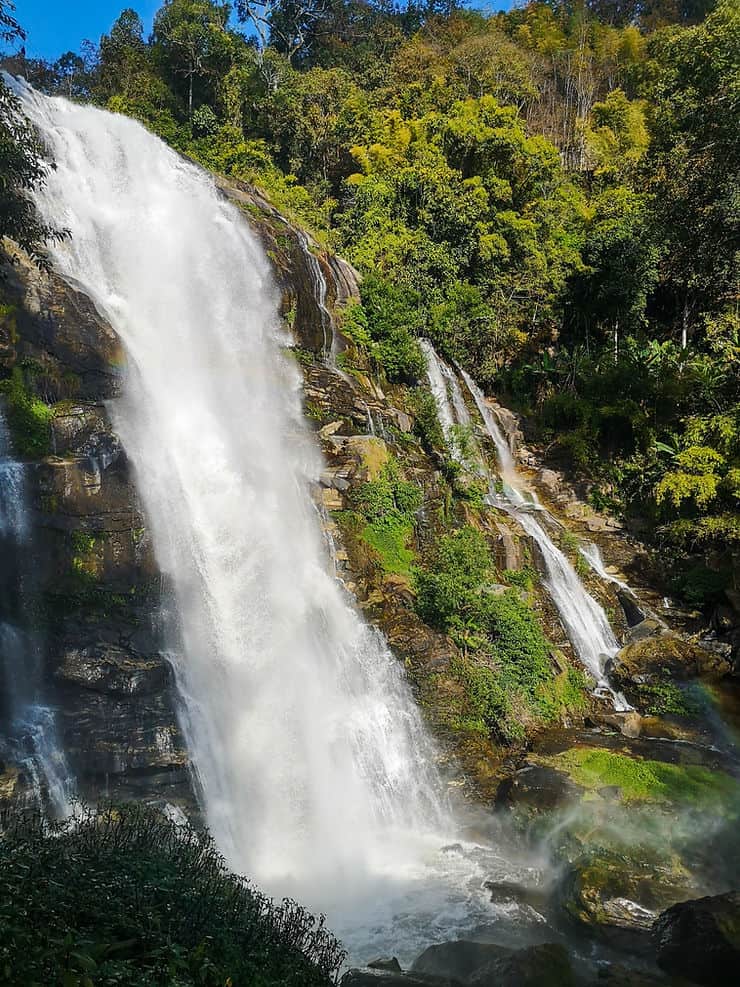
Day 3: Explore Chiang Mai’s beautiful temples
Thailand is well known for its beautiful temples and Chiang Mai is the city of temples. There’s so many Buddhist temples in Chiang Mai – 117 to be exact! You can’t wander too far without coming across one. So, why are there so many temples in Chiang Mai? Chiang Mai was once the capital of the Lan Na kingdom, which covered most of Northern Thailand. During this time, Chiang Mai was an important city for the kingdom as it was the centre of trade for the area and between surrounding countries. Because of the importance of Chiang Mai, many temples were built here during this time.
Wat Phra That Doi Suthep
The most famous temple in Chiang Mai is Wat Phra That Doi Suthep. This large temple complex sits on Doi Suthep mountain and offers stunning views over the city. You will have to drive or get a taxi to Doi Suthep, but it makes for a great day out, especially if you combine it with a visit to Wat Pha Lat, which sits further down the mountain.
Wat Chedi Luang
But, you don’t need to venture too far to see many of the beautiful must-see temples in Chiang Mai. Many of them are located in or around the old city.
One of the most impressive temples in Chiang Mai’s old city is Wat Chedi Luang. Dating back to 1481, the original chedi was built at 98m tall, making it the tallest in the city. Unfortunately, the top 30m of the chedi was destroyed in an earthquake and after restoration in the early 90’s, it now stands at just 50m tall. The Wat Chedi Luang also holds the city pillar shrine, which many claim to be the centre of the city.
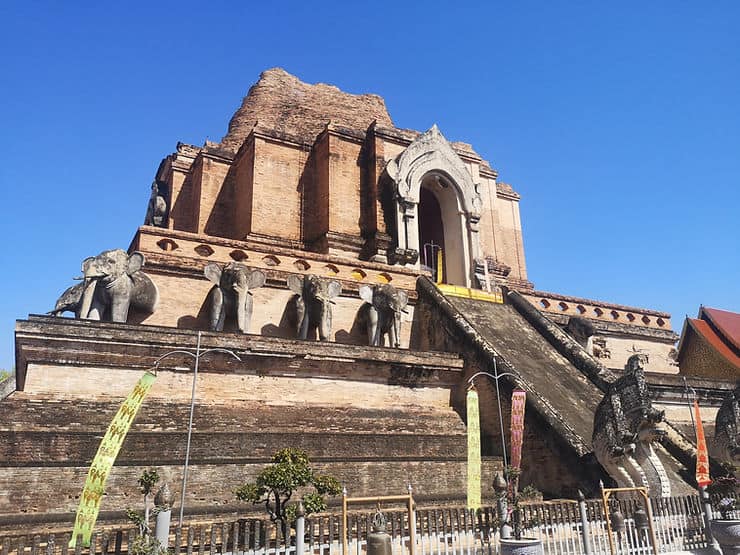
Chiang Mai's Oldest temple
The oldest temple in Chiang Mai is the Wat Chiang Man, dating back to the 13th century. This temple complex has two temple houses. Inside the first temple is Chiang Mai’s oldest Buddha. The second temple houses two more important Buddhas. One of the Buddhas is just 10cm tall and made out of crystal. This tiny crystal Buddha is thought to have protective and healing powers. The second significant Buddha in this temple is a standing Buddha. The standing Buddha is believed to bring rain for crops and is worshipped every April before the Songkran water festival.
Chiang Mai's smaller temples
Next to the well known Chedi Luang is the Wat Phan Tao. This temple is often overlooked, but is well worth a visit. The walls of the temple hall are made of teak wood, carved into beautiful decorations. At the time teak wood was an offering to the Buddha.
When visiting the Wat Phra Singh temple complex, make sure to go inside the Viharn Lai Kam assembly hall. Here, you will see detailed murals depicting traditional Thai life as it was hundreds of years ago.
Wat Lok Moki sits just outside of the city walls, on the north side. It is one of the oldest temples in Chiang Mai and has one of the tallest chedis in the area. Wat Lok Moki is not as shiny and highly decorated as some of the other temples, but is beautiful in an understated way.
Tips for visiting the temples in Chiang Mai
When visiting the temples in Chiang Mai (and anywhere in Thailand), you must be respectful and dress appropriately. Ladies must cover their knees and shoulders and avoid wearing tight gym-style leggings. When stepping inside a temple house, remove your shoes and hat.
Heading to Bangkok? Don’t miss these 3 amazing temples in Bangkok!
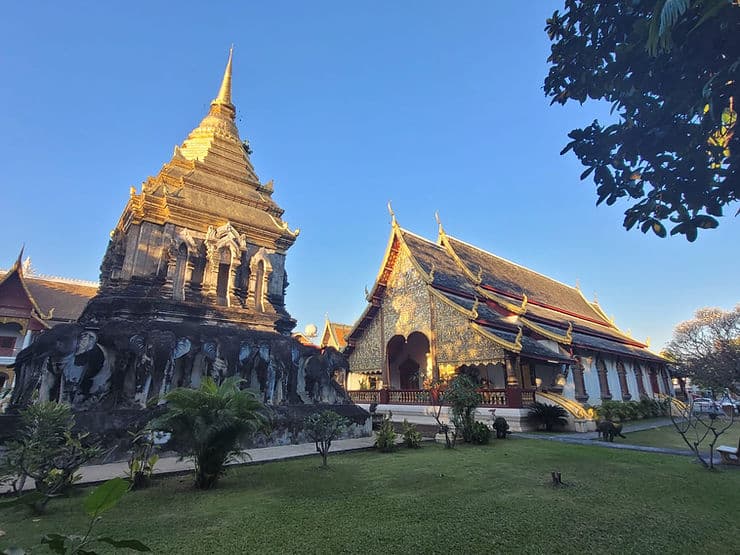
Day 4: Visit the Huay Keaw waterfall and Angkaew reservoir
Huay Keaw waterfall
Just on the edge of Chiang Mai city is the Huay Keaw waterfall. It’s a short 10 minute drive from the old city. Hop in a Songthaew taxi and spend the morning here. There is a short walking trail alongside the waterfall and you can walk to a viewpoint for views over the city. It’s worth noting that during the dry season the waterfall is not so full, so it’s better to visit between July and October when it is more impressive after the rain.
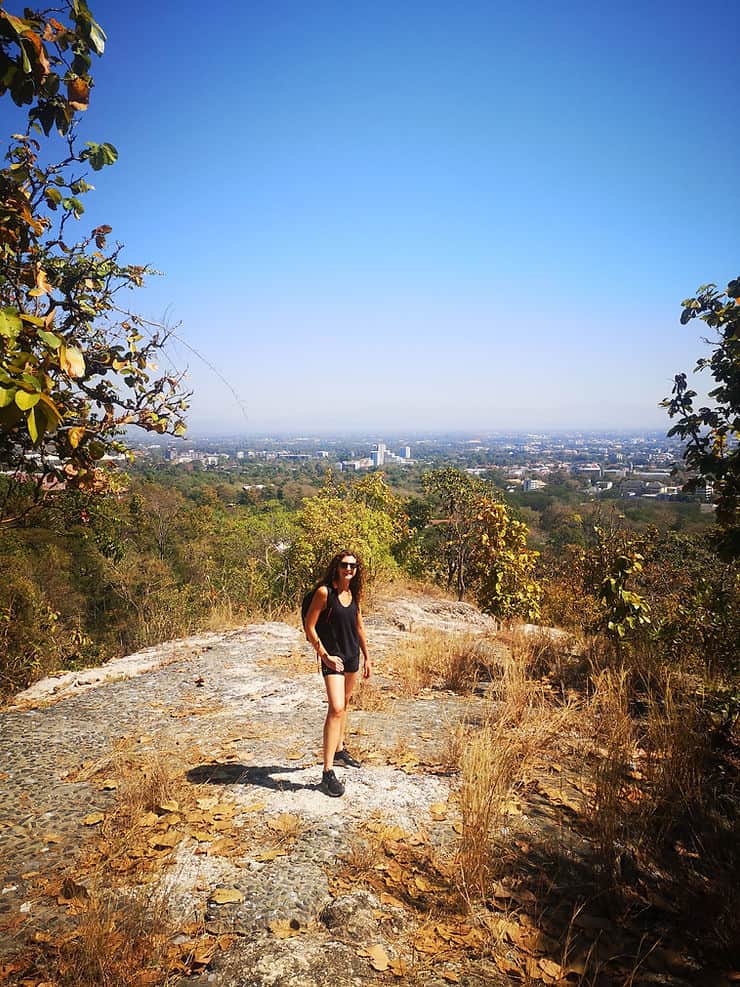
Angkaew reservoir
After spending the morning at Huay Keaw waterfall, either jump into a Songtheaw or take a walk to Angkaew reservoir. The reservoir is located on the grounds of Chiang Mai university, but it is open to the public. Enjoy a stroll round the small reservoir and take a picnic and a book and spend the afternoon relaxing.
Visiting Huay Keaw waterfall and the Angkaew reservoir is a great way to spend some time in nature whilst in Chiang Mai, without having to travel too far out of the city.
At the end of the day, check out the Chiang Mai university night market, just across the road from the campus. This small market has a great atmosphere and there’s plenty of street food stalls here as well as clothing shops.
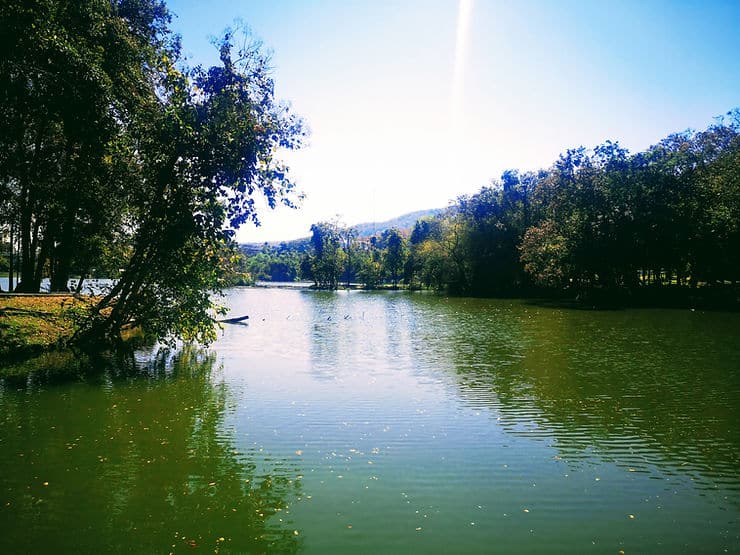
Day 5: Hike the Monks Trail to Wat Phra Lat and Wat Phra That Doi Suthep
If you want to go hiking in Chiang Mai, one of the best hiking trails in the city is the Monk’s Trail. This linear hiking trail will take you up through hilly woodland to the beautiful Wat Phra Lat and then continue onto Wat Doi Suthep. It’s a 6.5km out and back trail and it can be challenging as it ascends steeply on rocky ground. Good trainers or walking shoes are needed for this hike.
Wat Phra Lat
The first part of the hike to Wat Phra Lat is along a clearly marked path. Originally, Wat Phra Lat was used as a resting point for monks walking to Wat Doi Suthep. Although Wat Phra Lat is much more understated than Wat Doi Suthep, it has the most beautiful surroundings, nestled amongst the jungle. There are no crowds, cafes or shops at Wat Phra Lat, making it a very peaceful and tranquil place.
From here, you can choose to go back down to the start of the trail, or continue the hike up to Wat Doi Suthep.
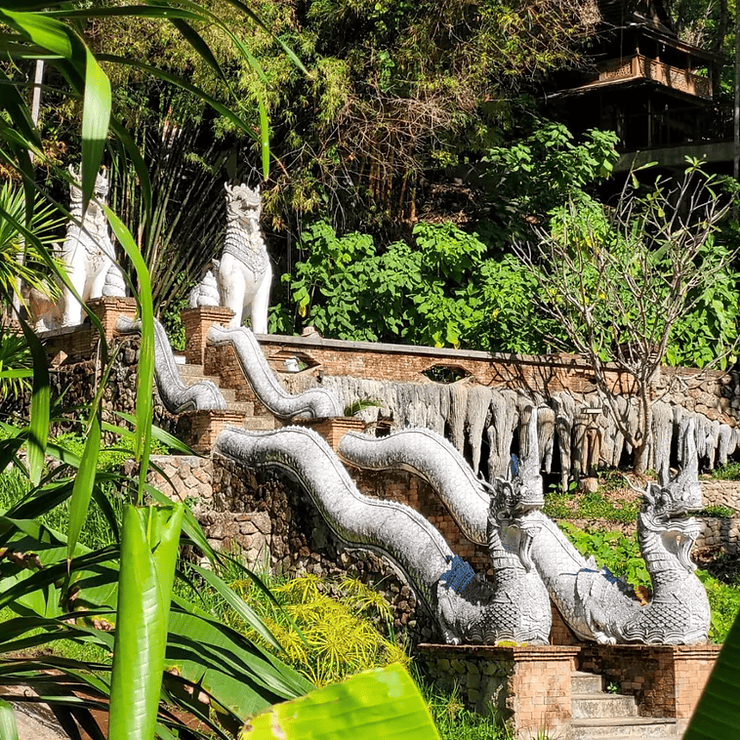
Wat Doi Suthep
This second part of the trail, from Wat Phra Lat to Wat Doi Suthep is quite challenging and is very steep in places. The trail is not well marked and is a little overgrown, making it difficult to find without a map. Not many people hike this route, so you are unlikely to pass too many people in this section.
Once you reach Wat Doi Suthep from the hiking trail, you will immediately be rewarded with panoramic views of Chiang Mai from the large terrace.
Wat Doi Suthep is one of the most visited temples in Chiang Mai. The whole complex is covered in gold – it is certainly not under-stated! At the centre of the temple complex is the main temple building and a large gold pagoda.
If you just want to visit Wat Phra That Doi Suthep, you can get a taxi or Songtheaw to the main entrance at the base of the temple. From here, you can either walk the 309 steps to the temple complex, or take the tram up.
Due to high visitor numbers, Wat Doi Suthep has unfortunately become quite commercialised. At the main entrance of the temple, there is a large covered market selling food, clothes, jewellery and crafts to tourists.
Doi Suthep Peak
From Wat Doi Suthep, there are many taxis waiting to take you back down to Chiang Mai city. However, if you want to extend your day, you can also take a taxi tour to explore the area around Doi Suthep peak.
The taxi tours tend to cover the same stops, including the Bubbing Palace, Hmong hill tribe village and Doi Suthep peak. But you can ask the drivers to customise it, depending on how long you have to spare.
At Doi Suthep Peak, the driver will drop you off and there is a short walk through the forest to the viewpoint, so bear this in mind if you hiked up to Doi Suthep. We didn’t realise this and were pretty tired by the end of the day!
Day 6: Have fun at Bua Tong waterfall (sticky waterfall)
The Bua Tong waterfall is one of the most popular trips from Chiang Mai. The natural waterfall is quite unique as you can climb up it! Thanks to the minerals in the rocks, they are not slippery. This means that you can easily walk up the rocks as the waterfall flows down over them. This sensation of being able to ‘grip’ to the rocks as you walk over them has given these waterfalls the nickname, ‘sticky waterfalls’. The walk up the waterfall is easy and far less strenuous than the Na Mueang waterfall hike in Koh Samui!
As well as climbing the waterfall, there is also a short nature trail and a picnic area. A couple of hours will be plenty of time here and it is a great way to spend the morning. Even better, it is completely free of charge to enter the sticky waterfalls!
The Bua Tong waterfalls are located 70km outside of Chiang Mai, so you will need to take a taxi. A grab car should cost around £20-£25 there and back as they will wait for you.
If you’d rather not arrange your own transport, book onto a tour to the Sticky waterfalls, often they will also take you to another local attraction en route, like this tour which combines the Sticky falls and Doi Suthep (perfect if you don’t fancy the walk up to Doi Suthep temple!)
Back in Chiang Mai, spend the afternoon treating yourself to a massage. There are plenty of massage salons and spas in Chiang Mai, including a centre run by female ex-prisoners. Just remember that the massages in Thailand are a little rougher than what you might be used to! If you prefer a more gentle massage, ask for an oil massage.
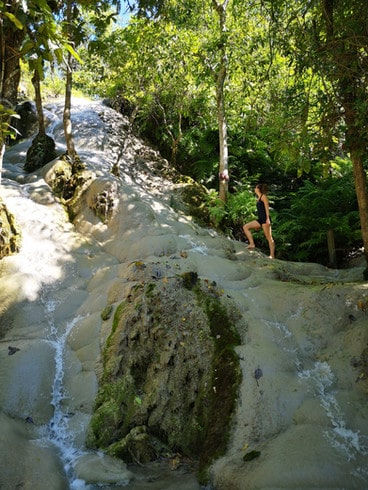
Day 7: Visit the Mahout Elephant Foundation
One of the most popular things to do in Thailand is to experience an encounter with an elephant. Whilst this is amazing, it is important that it is an ethical encounter and protects the welfare of the elephants. The Mahout Elephant Foundation is one of the best ethical elephant experiences in Thailand. It is a rescue and rehabilitation centre for elephants who have been saved from a working camp. There are several ways you can experience the elephants at the Mahout foundation and, as with all animal encounters, it is important that you research for yourself before visiting.
(Another great place to see elephants in Asia is at Udawalawe national park in Sri Lanka where you can take a safari tour to see elephants in their natural habitat).
What else is there to do in Chiang Mai?
If you have longer than 7 days in Chiang Mai then here are some other great things you can do in and around Chiang Mai:
- Take a trip to Northern Thailand’s Hidden Gem, Chiang Rai to see the famous White Temple
- Spend an afternoon at Huay Tung Tao Reservoir
- Watch a Muay Thai fight
- Visit San Kamphaeng hot springs
- Have fun at Grand Canyon waterpark
- Experience a Thai cooking class
- If you have 2 weeks in Thailand (or more), why not explore further afield, and visit Bangkok, Phuket or Pai
When is the best time to visit Chiang Mai?
Chiang Mai has 3 main seasons: cool (November to February), hot (March to May), and rainy (June to October). The best time to visit Chiang Mai is during the cool season, when the temperature is more bearable. The daytime in the cool season will see average temperatures at around 28 degrees Celsius. If you are exploring the mountainous regions around Chiang Mai, the temperature can drop to as low as 10 degrees due to the higher altitude, so just bear that in mind and take a warm layer.
It is best to avoid the months of March-April when visiting Chiang Mai. Not only is this the hottest time of year, but it is also when the ‘burning season’ is at its peak. Burning season is when farmers burn their crops, creating big, thick clouds of smoke and causing high levels of air pollution. Humidity is high and visibility is low during this time, making it quite uncomfortable. Book accommodation with air conditioning and stay indoors if you have respiratory conditions during the height of the burning season.
How to get to Chiang Mai
By plane: Chiang Mai’s international airport is well connected with other international and domestic routes, meaning that flying into Chiang Mai is really easy. It is just 10 minutes by taxi from the old city an a ride should cost about 150 thb.
By Bus: Chiang Mai has 3 bus terminals. Terminal 1 is just outside the old city walls and is mostly local buses connecting the city centre to the suburbs of Chiang Mai. Terminals 2 and 3 are located about 15 minutes east of the old city and from here buses connect Chiang Mai with other large cities in Thailand. You can also catch the minibus to Pai from here. Book your ticket in advance via 12go to secure your seat, especially in the busy peak season
By train: Chiang Mai railway station is 15 minutes east of the old city. From here you can catch trains from and to larger cities in Thailand, including the overnight sleeper train to Bangkok.
Getting around Chiang Mai
Chiang Mai is a large, busy city so unless you are very confident and experienced riding a scooter, it is best to use local transport instead. There are several options available for local transport in and around Chiang Mai.
Songthaews – These are the red trucks that you see everywhere in Thailand. Simply flag one down when you see it pass and tell them where you need to go. Often they will pick other passengers up along the way, so your journey might be longer, but this is usually the cheapest option of getting around.
Tuk-Tuks – Tuk-Tuks can be a fun way of exploring the city and many of them will offer 1 hour city tours for a set price. Tuk-Tuks are usually more expensive than Songtheaws and there are a lot of scams which can happen with Tuk-Tuk drivers, so just make sure that you agree on a price before getting in.
Grab – Grab or Line are both widely used in Chiang Mai and are a great low-cost way of getting around. The Grab taxis are private, air-conditioned cars and are a better option if you are travelling a longer distance.
Private taxis – Similar to Grab, private taxis can be a great way of getting out of the city. It is common to hire a private taxi for the day or half a day for a set fee. If you are happy with your driver, get their phone number and use them for several journeys throughout your stay – you’ll have a better chance of getting a good price each time this way.
Is Chiang Mai expensive?
The north of Thailand is often cheaper than the south and the islands, and Chiang Mai is no exception. Chiang Mai is very affordable, even for travellers on a tight budget, with a range of accommodation options around the city. I stayed at Lanna Tree boutique, which was conveniently located just inside the old city.
If you are looking for a more upscale hotel in a great location, check out this review of the Anantara Chiang Mai hotel.
In Chiang Mai, you’ll find plenty of local Thai restaurants serving good portions of delicious local food at very reasonable prices. To give you an idea, you can easily buy a meal and a drink for as low as £3!
There’s also plenty of great fresh markets and street food in Chiang Mai. Getting around is much cheaper in Chiang Mai than in the south too. Taxis cost less and using grab is great as you can see how much a taxi should cost when you’re planning your trips.
Where is the best place to stay in Chiang Mai?
The best place to stay in Chiang Mai is in the centre of the old city. This will give you easy access to the cafes, markets and restaurants. However, dependant on your budget and personal preference, there are a couple of good areas to stay in Chiang Mai.
Chiang Mai Old City
When you look at a map of Chiang Mai, you’ll see a square around the centre of the city. This is the boundary of the old city walls, some of which still stand, along with the city gates. Anything inside the square is classed as the old city. Accommodation is slightly higher inside the old city, however you have the advantage of being able to walk to many places, so you’ll save on transport costs.
If you choose to stay outside the old city, I would recommend staying somewhere close to one of the four gates, so that you have easy access to the amenities in the centre.
Chiang Mai North Gate (Chang Phuak)
There is a nightly food market at this gate, which is great for finding some cheap, delicious food. This entrance is also close to the impressive Wat Lok Moli temple.
Chiang Mai South Gate (Chiang Mai gate)
This is the main entrance for the Wua Lai Walking Street Saturday Market. There are many stalls here selling crafts, clothes and food, most of which will also have a stall at the famous Sunday night market. Like the North gate, there is also a nightly food market here.
Tha Phae Gate (east gate)
On the east side of the Old city, the area around the Tha Phae Gate is a popular place to stay. Again, there is a small nightly food market at the gate entrance. Tha Phae Road is a also a busy place with shops, cafes and bars.
Further away from the gate is the Chiang Mai Night Bazaar, which is located next to the Chiang Mai Marriott. The Night Bazaar is a large, lively market with a wide range of food, clothes, souvenirs and crafts.
Suan Dok Gate (west gate)
This is the quieter side of the old city, and is close to the city hospital and university. It is the closest entrance to travel to Wat Phra Lat, and Wat Doi Suthep and the green spaces around the outskirts of Chiang Mai, with many hiking trails.

